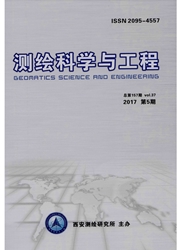

 中文摘要:
中文摘要:
不同的GNSS采用的坐标系定义几乎相近,但参考椭球及其坐标实现不同,这将影响多GNSS融合导航定位效果。根据各GNSS坐标系所采用参考椭球的基本常数,计算比较了不同坐标系参考椭球参数的差异;导出了相应的正常重力公式,比较了这些正常重力公式确定的正常重力值差异;最后分别从坐标系统的定义与实现两个方面分析了其对定位结果的影响。结果表明:1)GPS(BDS)与Galileo和GLONASS所使用的参考椭球引起正常重力差约为0.15和0.30mgal;2)GPS与BDS,Galileo及GLONASS所使用参考椭球引起纬度分量最大差异约为0.1mm,3cm和3cm,高程分量约为0.1mm,0.5m和1m;3)各GNSS所使用坐标框架间转换参数引起的坐标变化达到厘米级。
 英文摘要:
英文摘要:
Different navigation satellite system uses nearly the same coordinate system, but different ellipsoid and different coordinate frame are adopted, which result in the compatibility and interoperability problems for multi- constellation GNSS. It will also result in positioning discrepancy for geodesy users. According to the definition of el- lipsoid adopted by GPS, BDS, GLONASS and Galileo, the geometrical and physical parameters of ellipsoids are derived and compared with WGS84, CGCS2000, GTRF, PZ90.11, respectively. The corresponding normal gravity formulas are derived and the normal gravity values are computed in the different latitude, too. According to the da- tum definition, positioning differences are computed by using generalized coordinate transformation formulas. The ellipsoid differences among GPS (or BDS) and Galileo, GLONASS result in that the maximum normal gravity dis- crepancy about 0.15 mgal and 0.30 mgal, respectively. The ellipsoid differences among GPS and BDS, Galileo, GLONASS result in the maximum latitude discrepancy about 0.1 mm, 3 cm and 3 cm, respectively, while their el- lipsoid differences caused in the maximum height discrepancy about 0.1 mm, 0.5 m, and 1 m, respectively. Trans- formation parameters among coordinate frame of GPS, BDS, Galileo, and GLONASS result in the coordinate cm- diversification, which is not neglected by geodetic project.
 同期刊论文项目
同期刊论文项目
 同项目期刊论文
同项目期刊论文
 GNSS multi-carrier fast partial ambiguity resolution strategy tested with real BDS/GPS dual- and tri
GNSS multi-carrier fast partial ambiguity resolution strategy tested with real BDS/GPS dual- and tri A reference station-based GNSS computing mode to support unified precise point positioning and real-
A reference station-based GNSS computing mode to support unified precise point positioning and real- Estimation and mitigation of the main error of centimeter-level Compass RTK solutions over medium-lo
Estimation and mitigation of the main error of centimeter-level Compass RTK solutions over medium-lo Total least squares adjustment in partial errors-in-variables models: algorithm and statistical anal
Total least squares adjustment in partial errors-in-variables models: algorithm and statistical anal High-rate precise point positioning (PPP) to measure seismic wave motions: an experimental compariso
High-rate precise point positioning (PPP) to measure seismic wave motions: an experimental compariso Computed success rates of various carrier phase integer estimation solutions and their comparison wi
Computed success rates of various carrier phase integer estimation solutions and their comparison wi A new fusion scheme for accuracy enhancement and error modification in GPS/INS tight integrated navi
A new fusion scheme for accuracy enhancement and error modification in GPS/INS tight integrated navi 期刊信息
期刊信息
